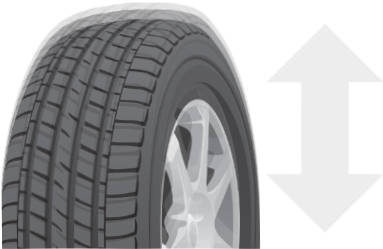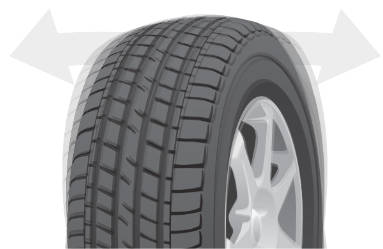How do I know if my tires need to be balanced?
You might need your tires balanced if you notice your steering wheel, seat or floorboard vibrates while driving at highway speeds, typically 45mph or higher.
An imbalance occurs when a wheel and tire assembly's distribution of weight or mass becomes uneven. It's very common because, despite their appearance, tires and wheels are not actually round. When placed together, the wheel and tire's absolute center of gravity rarely matches the center of the assembly. This causes vibration as the assembly spins on its center against the offset center of gravity. The vibration occurs continuously as the tire and wheel spin together on either the wheel or balancer.
So, what does balancing your tires do? Tire rebalancing weights restore the balance between the tire and the wheel assembly, making them spin on the same center of gravity thus removing the vibration.
There are a few different kinds of imbalances.
Static imbalances and Dynamic imbalances
Static imbalances occur when a light or heavy spot prevents the tire from rolling evenly, causing the tire and wheel to vibrate in an up-and-down motion.

Dynamic imbalances occur when unequal weight, on one or both sides of the tire's lateral centerline, causes a side-to-side vibration.

Most of the time, vibrations are a result of simultaneous static and dynamic imbalances.
But what causes an unbalanced tire? Imbalances and vibrations are commonly caused by runout, a condition created by the slightly imperfect shape of the wheel and tire.
Runout occurs when the wheel and tire assembly has a significantly higher point from its center than other places on the tire. Picture an egg that rolls on a table lengthwise, it won't roll smoothly because it's not perfectly round. Instead, its trajectory is bumpy and uneven. To correct this issue in tires, the high point of the tire is matched to the low point of the wheel.
How often should I balance my tires?
Regular balancing reduces the chance of an imbalance, which causes irregular or uneven treadwear. America's Tire recommends that drivers have their tires balanced every 6,000 miles. Don't wait for a problem to appear!
Many drivers only balance their tires after they notice a problem but it is much better and safer to perform regular maintenance. Your wheels, tires and other mechanical components like suspension will last longer and be less likely to sustain damage due to uneven wear.
Interestingly, modern vehicles tend to be more prone to imbalances. Older vehicles were heavier and provided a smoother ride by dampening vibrations before they affected the driver. However, today's vehicles are made of lightweight composite materials that do not do the same. Additionally, today's consumer trends veer more toward responsive tires with lower profiles, with narrow sidewalls that do not resist imbalances and vibrations.
The plus-sized tires and wheels that are popular among today's drivers have an even greater sensitivity to imbalances.
What is the tire balancing process?
In the tire balancing process, a technician uses a highly calibrated balancer and then applies wheel weights (measured in ounces) to evenly distribute the weight of a tire and wheel assembly. This eliminates or minimizes any vibrations to ensure a smooth ride, while also reducing wear and tear on suspension components.
The state-of-the-art balancing machine has a spindle that fits through the center bore of the wheel and then uses an adaptor that perfectly centers the assembly on the machine. The machine then spins the assembly at high speeds to determine its heaviest point. The machine indicates where to place the weights that will compensate for the wheel and tire assembly's heavy spots.
Then, the technician attaches clip-on weights onto the lip contours of the wheel. Older versions of these weights were made of lead but now they are often made from environmentally friendly zinc or steel. Many aftermarket wheels have smooth surfaces and delicate finishes and may lack contoured lips to clip the weights. For these, the tech places adhesive weights behind the wheel face. Some wheel styles require both clip-on and adhesive weights.
If you're looking for ways how to balance your tires, let a professional tire and wheel shop take care of it for you. Properly balancing tires and wheel assemblies requires specific machinery and expertise. Plus, it is one of the many free services we offer to our customers after your tire purchase for the life of tire maintenance. Also check out our exclusive Certificates, better than any warranty out there!
CertificatesOther causes of vibration
There are several other causes of vibration besides tire imbalances. For example, a bent wheel, an out-of-round tire, brake component wear, suspension wear or suspension alignment could be causes of vibration detectable by the driver. In these cases, a technician will use an advanced balancer called a road force balancer which operates like a traditional spin balancer but also collects other data that might explain the issue.
If you have any questions or need any assistance, stop by your local America's Tire and we'll get you taken care of. Get a shorter wait time in-store when you buy and book online!
